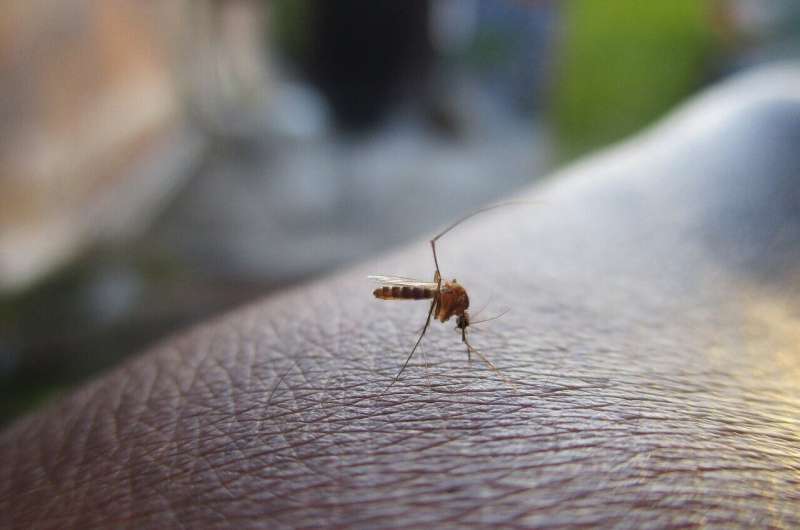Research on brain swelling in children with cerebral malaria reveals potential new treatment approach

Through investigating the causes of brain swelling in cerebral malaria—a devastating parasitic disease that is fatal for one in five children—scientists have found a potential new treatment approach that could be safely used to improve outcome.
New international research, led by the University of Glasgow and published today in Blood Advances, shows that modified heparins—a medication already proven safe to use in malaria patients—may offer a new approach to treating cerebral malaria in children. The work used a combination of lab and patient research, and scientists hope the findings will later be confirmed in clinical trials.
Despite continuing global efforts to reduce the incidence and transmission of malaria, the parasitic disease kills nearly half a million people every year—mainly young children in Africa.
Cerebral malaria is the most severe form of the disease. Plasmodium parasites, which infect red blood cells, bind to and damage the small blood vessels in the brain resulting in seizures or coma. For one in five patients, cerebral malaria is fatal. In children who survive, it frequently causes long-term disability. Therefore, any treatment that improves outcomes for this devastating condition could save many lives and improve the quality of life for survivors.
During cerebral malaria, fluid leaks out from blood vessels in the brain. At its most severe, this produces swelling, squashing the area of the brain that controls breathing and results in death. In this research scientists focused on the underlying mechanisms that cause the vessels to leak, and the study evidence suggests that a group of proteins called histones, released by the parasite, may be involved.
Leakiness from human histones can be blocked by heparins—a drug widely used in patients to prevent blood clotting. Standard heparins can cause bleeding, but this bleeding risk can be prevented by generating modified heparins (non-anticoagulant heparins). In this research, modified, non-anticoagulant heparins were able to block toxicity and leak from parasite histones in laboratory experiments. Modified heparins have been shown to be safe in patients with malaria in whom they had other potentially beneficial effects.
Dr. Christopher Moxon, of the University of Glasgow's Wellcome Centre for Integrative Parasitology, who led the study, said: "Our findings, that identify a potential treatment target and potentially deployable treatment for cerebral malaria, may be an important step toward improving clinical outcomes for patients with this devastating disease."
In this study, scientists measured histone levels in 314 Malawian children. They included 147 children with confirmed cerebral malaria, children with milder malaria, and other very sick children in a coma who did not have malaria. Histone levels were far higher in the cases with cerebral malaria than in the other groups. In the cerebral malaria group using a novel assay and a highly sensitive device called a mass spectrometer, they were able to show that a high proportion of these histones were specifically produced by the parasite.
To assess the potential association between histone levels and fluid leakage in the brain they performed magnetic resonance imaging scans in the children with definitive cerebral malaria, to assess the level of brain swelling. Their investigation showed that the histone levels were higher in children with more brain swelling.
In brain samples from 16 children who died from cerebral malaria they observed that the histones were stuck to brain vessels in proximity to concentrations of the parasite and were stuck to blood vessels precisely in the areas where vessels were leaky. The suggestion from these data is that the histones from the parasite might be causing this leakiness and might be a target for a treatment.
To test their theory the scientists used a model in the lab where brain endothelial cells are grown to form a barrier like they do in vessels in the brain. The leakiness in these vessels can be measured. Putting parasite histones or blood samples from malaria patients onto a layer of the endothelial cells in the lab caused leakiness.
Dr. Moxon said: "Building on work from others our findings suggest that histones, at least in part released from the parasite, may be an important contributor to leak and brain swelling in cerebral malaria and that non-anticoagulant heparin may be a safe and deployable treatment that can reverse this. Further investigations are needed to follow up our findings and to assess the potential of non-anticoagulant heparins as a treatment, which would ultimately need to be tested in a clinical trial."
The study, "Parasite histones are toxic to brain endothelium and link blood barrier breakdown and thrombosis in cerebral malaria," is published in Blood Advances.
More information: Christopher A. Moxon et al. Parasite histones are toxic to brain endothelium and link blood barrier breakdown and thrombosis in cerebral malaria, Blood Advances (2020). DOI: 10.1182/bloodadvances.2019001258



















